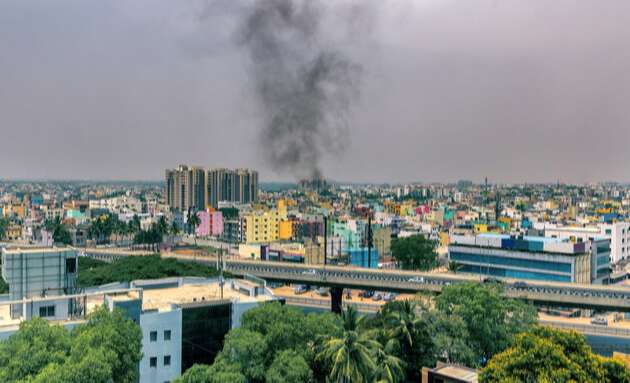5 Pollutants in the Air That Are Dangerous for Your Health

Air Pollution is a serious health and environmental hazard in India. Increased exposure to polluted air can cause a host of dangerous illnesses in individuals, developing fetuses, and newborn children.
In order to protect yourself from the harmful effects of air pollution, it is important to be aware of common pollutants in the air and understand their effect on your health. Here is a list of the most common air pollutants in India and their impact on your health.
-
Particulate Matter (PM)

Particulate matter refers to extremely small solid particles and liquid droplets that are found in the air around us. They can be made up of a variety of components like nitrates, sulphates, dust particles, and allergens such as pollen. They are ejected into the air from motor vehicles, wood and crop burning, and factories.
Depending on its size, particulate matter is categorized either as PM10 or as PM2.5. Particles with a diameter of 10 micrometres (10 μm) or less are classified as PM10, while those with a diameter of 2.5 micrometres (2.5 μm) or less are classified as PM2.5.
PM10 is small enough to pass through the throat and nose, and enter the lungs. Once inhaled, it can affect the heart and lungs and cause serious health effects. PM2.5, on the other hand, is so small that it can not only enter your lungs but also get into your bloodstream.
Short-term exposure to particulate matter (few hours or days) can lead to irritation in the eyes, nose and throat, and can also worsen asthma and lung disease in individuals. Long-term exposure (over many years) can lead to reduced lung function and cardiovascular or respiratory diseases.
According to the World Health Organization, 14 out of the 15 most polluted cities in the world in terms of PM 2.5 concentrations are in India.
-
Sulphur Dioxide (SO2)
Sulphur dioxide, a colourless gas with a pungent odour, is a by-product of fossil fuel combustion and is also released by natural processes, such as volcanic eruptions.
Sulphur dioxide contributes to particulate matter pollution. It irritates the lining of the nose, throat and lungs, and could worsen existing respiratory and cardiovascular ailments in individuals. It can also cause a narrowing of the airways, leading to wheezing, chest tightness, and shortness of breath.
-
Carbon Monoxide (CO)

Carbon monoxide is an odourless, colourless gas and is usually generated by motor vehicles and factories. It is also contained in cigarette smoke.
Carbon monoxide can restrict the amount of oxygen that reaches the body’s organs and tissues. At extremely high levels, it can also cause death. Exposure to carbon monoxide can cause flu-like symptoms such as headaches, dizziness, disorientation, nausea, and fatigue. It can also cause chest pain in people with coronary heart disease. At higher concentrations, carbon monoxide can cause individuals to suffer from impaired vision and can cause serious health effects in unborn babies. -
Nitrogen Dioxide (NO2)
Nitrogen dioxide is formed by emissions from motor vehicles, industries, and gas stoves. High concentrations of the gas can be found near busy roads, and indoors when using gas for cooking.
Nitrogen dioxide causes air-passage inflammation, infections such as influenza and pneumonia, and increased susceptibility to lung infections, allergens and asthma triggers. It also contributes to the formation of ground-level ozone and particulate matter.
-
Ozone (O3)

Ozone is found both in the earth’s upper atmosphere and at ground level. In the upper atmosphere, ozone protects us from harmful ultraviolet rays. At ground level, however, it is dangerous for our health.
Ozone is the main component of smog. It is a product of the interaction between sunlight and emissions from motor vehicles and industries. It can cause irritation and inflammation of the eyes and nose, coughing, a sore and scratchy throat, a tight chest, and reduced lung function. Just like other air pollutants, it can aggravate asthma and chronic respiratory diseases.
Air pollution certainly cannot be avoided altogether. That said, there do exist precautions you can take to reduce its ill effects on your health. The next time you step out of your house, check the air quality index for pollution in your neighbourhood. If the air quality is poor, consider staying in or working from home. If you do need to go out, use a mask to protect yourself from inhaling particulate matter.






